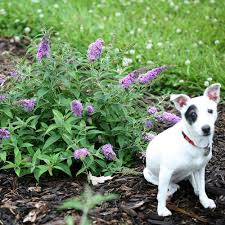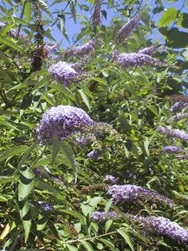Butterfly Bush (Buddleja davidii)
Butterfly bush is a Class B noxious weed on the Washington State Noxious Weed List. It is on the Non-Regulated Noxious Weed List for King County, Washington. Control of butterfly bush in King County is recommended but not required. Butterfly bush is not on the prohibited plants list administered by the Washington State Department of Agriculture, but some nurseries have volunteered to stop selling it due to its danger to natural resources.
- Deciduous shrub up to 15 feet tall with arching branches
- Showy flower spikes grow at the branch ends, either upright or often nodding, 4 to 10 inches long
- Flowers typically light purple with orange centers (hence the common name “orange eye”), four-petaled, bell-shaped, and in dense clusters
- Cultivars have been developed with a range of colors including red, magenta, blue, orange, yellow, white and dark purple
- Young stems are green, older stems have peeling, gray-brown bark
- Leaves are long and narrow or somewhat egg-shaped and arranged oppositely on the branches
- Leaves are usually 4 to 10 inches long and 1 to 3 inches wide
- Edges of the leaves are toothed
- Upper leaf surface is deep green to blue-gray, while the undersides seem whitish due to dense covering or short, fuzzy hair
- Flowers bloom between mid-summer and the first frost in Washington State
- Seed capsules split in two to release small, winged seeds
 Habitat and impact
Habitat and impactButterfly bush is most vigorous in well-drained soil and full sun. It can tolerate drought and low-nutrient soil and can grow in very challenging conditions, such as cracks in the pavement and along railroads. Seeds require exposed soil to germinate successfully and seedlings are not often seen in improved garden soils or well-maintained landscapes.
Butterfly bush colonizes disturbed areas such as riversides, roadsides, railroads, pastures, and recently logged or burned forests. Invasion of butterfly bush along riversides is especially problematic, because it forms dense thickets, crowds out native vegetation, and disrupts natural succession patterns. Initial densities of seedlings along open areas of riverbanks and sandbars can be very high and mature butterfly bush stands keep out native willows and other woody vegetation that would normally re-vegetate riverbanks after floods.
 Growth and reproduction
Growth and reproductionButterfly bush spreads by producing abundant amounts of very lightweight, winged seeds that are dispersed by wind and water over many miles. A study at Longwood Gardens in Pennsylvania found that a single flower spike produced 40,000 seeds. The germination rate of several cultivars was 80 percent or higher. This species is quick to mature, often producing seeds during its first year of growth. Also, butterfly bush is adapted to surviving along riversides and can develop roots on branches that have been buried or broken off.
Once established, butterfly bush is tough to eliminate. Seeds remain viable in the soil for 3 to 5 years. Butterfly bush can re-sprout from the rootstock after it can been damaged or cut down to its base, and the cut stems can grow into new plants if not disposed of properly.
 Control
ControlPrevention: Don’t let butterfly bush go to seed. Remove spent flowerheads in the fall before they disperse seeds (don’t wait until spring) and discard these in the garbage to avoid spreading seeds. Consider using other species in your landscape (see the garden wise publication for suggestions). For existing plantings, consider removing the butterfly bush to prevent its spread.
Manual control: Seedlings can be easily hand-pulled and larger bushes can be dug out (with some effort). Weed wrenches can work, but trunks are often too brittle and break off. Watch for new seedlings where the soil was disturbed and consider planting grass or a ground cover to suppress future seedling germination of the butterfly bush seeds remaining in the soil.
Disposal: Branches should not be left on the bare ground because they can form roots and re-grow. Do not discard branches or root balls in natural areas or on roadsides because they can re-grow and spread. Branches can be burned, put in your yard waste container, or taken to a landfill or yard waste composting facility. Seedheads should be discarded in the garbage. If you cut seedheads after the fall, place a bag around them before cutting off to minimize dispersal of the seeds.
Chemical control: Controlling butterfly bush by spraying with a brush-control herbicide is somewhat effective, but for better results, cut the trunk off at the base and apply concentrated glyphosate (such as in Roundup) or triclopyr (such as in Garlon or Brush B Gon) to the freshly cut surface. For more detailed information on the cut stump treatment method and more information on using herbicides to control weeds in different crops and locations, please see the Pacific Northwest Weed Management Handbook. Always follow the label directions on any herbicide product you use to minimize any potential risks to you and the environment, and follow all applicable laws and regulations regarding herbicide use on your site. Contact the Noxious Weed Program if you are unsure about what to do.
Biological control: There are currently no biocontrol agents available for managing butterfly bush. See the biological control page for more information.
Cultural/grazing: Although goats will eat butterfly bush and can cause damage to the plants, they will not kill or eradicate this plant. Consider using goat grazing as part of an integrated program with other methods, perhaps followed up by manual or chemical treatment.
Additional information on butterfly bush
- Washington State Noxious Weed Control Board (external link)
- King County butterfly bush weed alert (download Adobe Acrobat file)
- WSU Extension Butterfly Bush Bulletin (download Adobe Acrobat file)
- University of Washington Burke Museum Herbarium Image Collection – Buddleja davidii (external link)
- Oregon Department of Agriculture Butterfly Bush Profile (external link)
- Garden Wise: Non-invasive Plants for Your Garden (external link)


